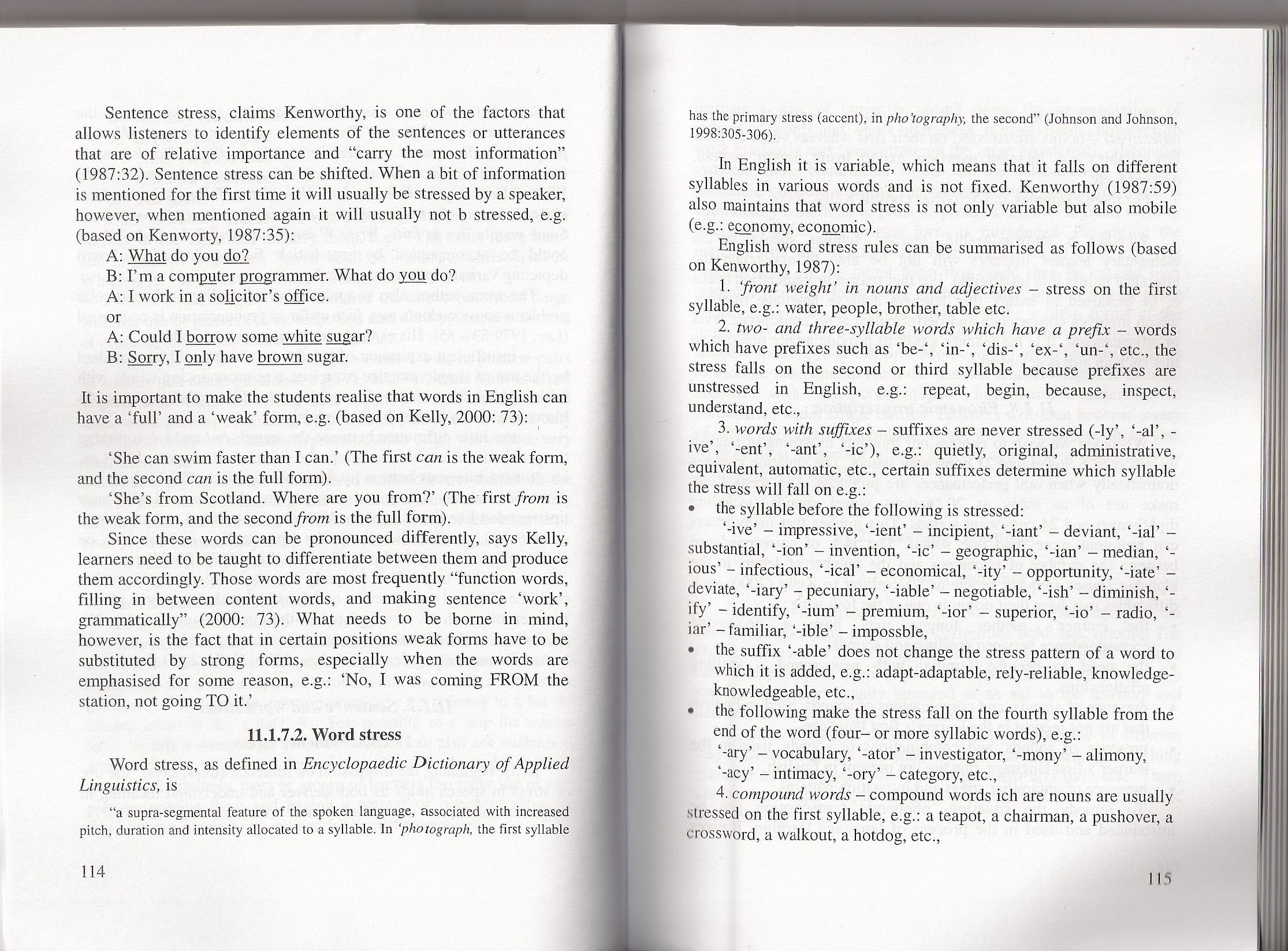skanowanie0057 (7)

Sentence stress, claims Kenworthy, is one of the factors that allows listeners to identify elements of the sentences or utterances that are of relative importance and “carry the most information” (1987:32). Sentence stress can be shifted. When a bit of information is mentioned for the first time it will usually be stressed by a speaker, howeyer, when mentioned again it will usually not b stressed, e.g. (based on Kenworty, 1987:35):
A: What do you do?
B: I’m a Computer programmer. What do vou do?
A: I work in a solicitor’s office.
or
A: Could I borrow some white sugar?
B: Sorry, I only have brown sugar.
It is important to make the students realise that words in English can have a ‘fuli’ and a ‘weak’ form, e.g. (based on Kelly, 2000: 73):
‘She can swim faster than I can.’ (The first can is the weak form, and the second can is the fuli form).
‘She’s from Scotland. Where are you from?’ (The first from is the weak form, and the second from is the fuli form).
Since these words can be pronounced differently, says Kelly, leamers need to be taught to differentiate between them and produce them accordingly. Those words are most freąuently “function words, filling in between content words, and making sentence ‘work’, grammatically” (2000: 73). What needs to be borne in mind, however, is the fact that in certain positions weak forms have to be substituted by strong forms, especially when the words are emphasised for some reason, e.g.: ‘No, I was coming FROM the station, not going TO it.’
11.1.7.2. Word stress
Word stress, as defined in Encyclopaedic Dictionary of Applied Linguistics, is
“a supra-segmental feature of the spoken language, associated with increased pitch, duration and intensity allocated to a syllable. In ‘photograph, the first syllablęp has the primary stress (accent), in pho ’tography, the second” (Johnson and Johnson, 1998:305-306),
In English it is variable, which means that it falls on different syllables in various words and is not fixed. Kenworthy (1987:59) also maintains that word stress is not only variable but also mobile (e.g.: economy, economic).
English word stress rules can be summarised as follows (based on Kenworthy, 1987):
1. ‘front weight’ in nouns and adjectives - stress on the first syllable, e.g.: water, people, brother, table etc.
2. two- and three-syllable words which have a prefbc — words which have prefixes such as ‘be-\ ‘in-‘, ‘dis-1, ‘ex-\ ‘un-‘, etc., the stress falls on the second or third syllable because prefixes are unstressed m English, e.g.: repeat, begin, because, inspect, understand, etc.,
3. words with suffixes - suffixes are never stressed (-ly\ ‘-al’, -ive\ ‘-ent’, ‘-ant’, ‘-ic’% e.g.: ąuietly, original, administrative, equivalent, automatic, etc., certain suffixes determine which syllable the stress will fali on e.g.:
• the syllable before the following iś stressed:
‘-ive’ - impressive, ‘-ient’ - incipient, ‘-iant’ - deviant, ‘-ial’ -substantial, ‘-ion’ - invention, ‘-ic’ - geographic, ‘-ian’ - median, ‘-ious’ - infectious, ‘-ical’ - economical, ‘-ity’ - opportunity, ‘-iate’ -deviate, ‘-iary’ - pecuniary, ‘-iable’ - negotiable, ‘-ish* - diminish, ‘-ify’ - identify, ‘-ium’ - premium, ‘-ior’ - superior, ‘-io’ - radio, 4-iar’ - familiar, ‘-ible’ - impossble,
• the suffix ‘-able’ does not change the stress pattem of a word to which it is added, e.g.: adapt-adaptable, rely-reliable, knowledge-knowledgeable, etc.,
• the following make the stress fali on the fourth syllable from the end of the word (four- or morę syllabic words), e.g.:
‘-ary’ - vocabulary, ‘-ator’ - investigator, ‘-mony’ - alimony, ‘-acy’ -intimacy, ‘-ory’ - category, etc.,
4. compound words - compound words ich are nouns are usually stressed on the first syllable, e.g.: a teapot, a chairman, a pushover, a crossword, a walkout, a hotdog, etc.,
115
Wyszukiwarka
Podobne podstrony:
image002 “There has never been a collection like this before” James Blish. . . and there hasn’t. Thi
S20C 409120813423 fortunę cookie scarf Dynamie niowment is one of Ihe many qualities sinbori Level I
Introduction INTRODUCTION The Basilica of St. Peter is one of the most important eccle-siastical bui
ms 029 S./Lgr. T W. UATCH, of Rushden, Northants, is one of thc happiest men a!ivc, for to-day heca
New Forms Taschen 071 Holi is one of the morę thoughtful contemporary architeas. He has written, &qu
1 Rachunek Zdań Reductio ad absurdum, which Euclid loved so much, is one of a mathematician’s f
• Andrzej Chodyński, Wojciech Huszlak •3.1. Charitable activity Today, charity is one of the most po
Effect Of Dividends On Slock Prices 3 1. Introduction Dividend policy is one of the most widely rese
86 A. Wawrzak, K. Karwowski, K. Karwowski, S. Mandra, M. Mizan1. INTODUCTION High precision machinin
sWESTERN: SPOLAND!2 SUMMARY The Strategy for Development of Western Poland 2020 is one of the develo
20470 IMGP4957 Wilms’ tumour • Wilms1 tumour (WT; nephroblastoma), a kidney n
node list Latest NewsNews _ No news is TTJHB uood news. fl
So the identity with the body is one of the first things which makes an ego; it is the
r t* The Onkyo TX-4000 Quartz Synthesized Tuner/ Amplifier is one of the most perfect stereo
więcej podobnych podstron